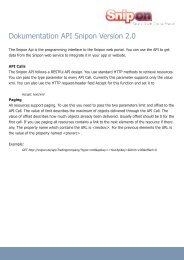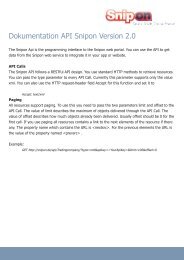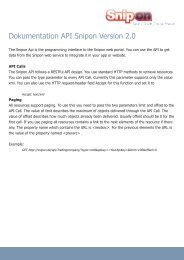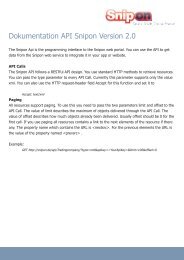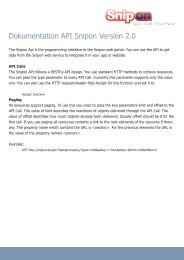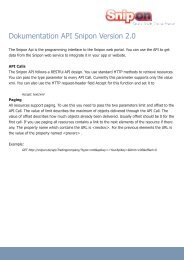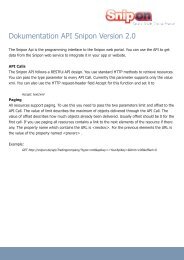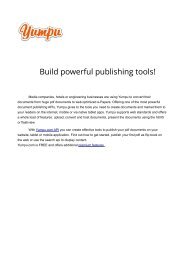test_pdf.pdf
You also want an ePaper? Increase the reach of your titles
YUMPU automatically turns print PDFs into web optimized ePapers that Google loves.
ASSESSING<br />
THE RECORD<br />
OF ARMS<br />
CONTROL<br />
us this morning on controlling the spread of nuclear weapons.<br />
NOBUYASU ABE: Thank you, Professor Steinbruner.<br />
I’m pleased to be here participating in the Paul Warnke Conference. I traveled from New York yesterday to<br />
snowy Washington, D.C. These days it’s always challenging to travel by air because you’re constantly reminded of<br />
the terrorist threats. You have to remove everything—almost everything metallic from your body. You even have to<br />
remove your shoes. I think sooner or later, you may have to come to the airport in pajamas and get on the plane.<br />
(Laughter.)<br />
But I’m all in favor of security measures against terrorist threats. I took advantage of my stay in Washington<br />
yesterday to measure the temperature in the capital of the United States for arms control and disarmament. I’m afraid<br />
the temperature’s not so high in Washington. But today I think we can help raise the temperature.<br />
Since Mr. Newhouse just addressed the U.S.-Soviet and U.S.-Russia relationship and other speakers will be<br />
addressing the problem of chemical and biological weapons, I will focus upon the past international efforts in the<br />
field of nuclear disarmament and nonproliferation and their successes and failures. I think the ultimate <strong>test</strong> of the<br />
success in these fields can be summarized by one word: results. By results, I do not mean simply signatures of this or<br />
that document or pleasant words uttered at ceremonial diplomatic occasions. When it comes to nuclear arms control<br />
and disarmament, results consist of real achievements in reducing and eliminating the risk of the willful or accidental<br />
use of nuclear weapons. The assumption is that the greater the number of nuclear weapons and the wider they are<br />
spread, the greater is the risk they [might be] used willfully or accidentally.<br />
The international community has worked for many decades to achieve results using a variety of means—in<br />
particular, national and multilateral measures against the global proliferation of nuclear weapons and to promote<br />
nuclear disarmament, as well as more recent efforts to combat nuclear terrorism. Though nuclear arms control has<br />
experienced its ups and downs over the years, it is to the progress that I would first like to turn.<br />
Over a half century after the nuclear attacks at Hiroshima and Nagasaki, we are fortunate indeed to observe<br />
that there has not been even a single use of nuclear weapons and that there are only five recognized nuclear-weapon<br />
states, and only four states with the non-recognized nuclear weapons capability outside the NPT [nuclear Nonproliferation<br />
Treaty]. George Bunn recently estimated that without the NPT, there could have been at least 28 additional<br />
states with nuclear weapons. This alone is a significant achievement. Several states, including South Africa, Brazil,<br />
and Argentina have voluntarily given up their nuclear weapons programs. There are now four regional nuclearweapon-free<br />
zones, which cover virtually the entire southern hemisphere; not to mention treaty regimes that prohibit<br />
the stationing of nuclear weapons on the seabed, in Antarctica, in orbit, on the moon and other celestial bodies, or the<br />
<strong>test</strong>ing of such weapons at sea, in the atmosphere, or in space.<br />
Commitments on paper like these can be quite meaningful, but commitments backed by credible verification<br />
measures bring us closer to what I would call real progress in nuclear arms control. The IAEA [International Atomic<br />
Energy Agency] safeguards system is one such measure to the extent that it has served as an intrusive, agreed,<br />
multilateral means to verify the peaceful uses of nuclear material. While these safeguards have by no means eliminated<br />
all threats from the misuse of peaceful nuclear technology or material, the world is undoubtedly better off with<br />
these binding, intrusive safeguards than without them. The new authorities contained in the Additional Protocol<br />
will further enhance the ability of safeguards to verify the peaceful use of commitments.<br />
More generally, I must note, on the positive side of the ledger, the enormous, virtually universal support that<br />
exists in the world today for the fundamental norms of nonproliferation and disarmament and against nuclear<br />
terrorism. This support is demonstrated not just in declaratory resolutions adopted each year in the UN General<br />
Assembly but in the form of legally binding commitments made by states to regional and global nuclear arms control<br />
treaties, commitments that are increasingly being reinforced by concrete national actions.<br />
The indefinite extension of the NPT in 1995 and the adoption a year later of the Comprehensive Nuclear Test<br />
Ban Treaty [CTBT] were two specific landmark events in the evolution of nuclear arms control norms. Though the<br />
latter has not yet entered into force, the world has witnessed for many years now a de facto moratorium on nuclear<br />
<strong>test</strong>s, and the steady buildup of the international monitoring system under the provisional CTBT Secretariat, adding<br />
a significant deterrence against any clandestine <strong>test</strong>ing.<br />
I have to recall, however, that negotiation of this treaty was a major part of the package deal that led to the NPT’s<br />
indefinite extension in 1995. After all, the NPT succeeded in preventing a significant number of industrial nations<br />
that had significant technological capability at that time from acquiring nuclear weapons. With the passing of time,<br />
that non-nuclear-weapon status has settled down very well in those countries’ body politics.<br />
Preventing such nations as Japan, Germany, Sweden, Switzerland, Canada, and Australia [from pursuing<br />
nuclear weapons] is no means a small accomplishment. If it is about conventional weapon, I think the NPT would<br />
have very well earned a passing grade. But the nature of such WMD [weapons of mass destruction] as nuclear<br />
11<br />
11



